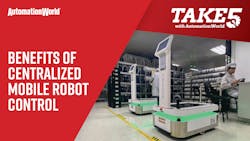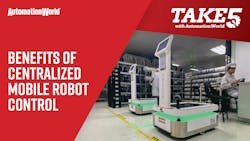
Benefits of Centralized Mobile Robot Control
Quick hits:
- Autonomous mobile robots (AMRs) are one of the fastest growing segments in robotics.
- Although progress has been made in their deployment, safety and interoperability are among the greatest remaining barriers to ubiquitous adoption.
- By using a single, centralized controller, the sophisticated software intelligence and supporting hardware inside individual AMRs can be removed, reducing per unit costs.
Related to this episode:
- Artificial Intelligence for Mobile Robot Fleet Management
- 5G Expands Autonomous Mobile Robot Capabilities
- Mobile Robot Safety Standard Published
- Robotics Adoption Survey Finds Ups, Downs, and a Few Surprises
- Read PMMI's report on the drive toward 4.0 connectivity in packaging and processing.
Hello and welcome to Take Five with Automation World. I’m David Miller, Senior Technical Writer for Automation World. Today I'm going to talk about a novel approach to control for fleets of autonomous mobile robots—which I'll refer to as AMRs—that uses a centralized AI control tower, rather than nesting intelligence inside each individual robot.
AMRs are actually one of the fastest growing segments in robotics. Automation World found in its recent robotics survey that they gained a lot of steam during COVID-19 when their use in the logistics and warehousing spaces allowed for contact free material handling amidst worker shortages. And they've evolved a lot over time to be more user friendly and quick to deploy. We see all kinds of robots as a service models, for instance, and we see their setup and configuration becoming more and more intuitive. However, there are still some challenges when it comes to interoperability and fleet management.
Right now, a lot of AMRs on the market operate as stand alone robots that contain sophisticated internal intelligence which is supported by very expensive onboard hardware. In a word, computing capacity. This is what makes them so smart -- so capable of navigating autonomously, as it where. But the result is that configuring them to work in tandem with one another can be a complex task for integrators, particularly if AMRs from different vendors are being used within the same facility. Not only that, but it increases per unit price.
So, a company called 634AI recently devised an alternative means of controlling an AMR fleet, which they think could eliminate this complexity while also reducing costs. They call it Maestro, and it's a centralized AI control tower that works by monitoring a plant or warehouse floor with vision systems and then issuing commands based on the positions of robots. So, it has a bird's eye view, continuous visibility of where all things are at all times, and it's using its massive onboard intelligence to issue commands to the robots based on the activities of the entire fleet.
So, this is like a control tower at an airport that coordinates activities. By contrast, imagine if you told every plane to just land as best as they could—or if you gave every individual plane access to a map of where all the other planes are and told them to figure it out on their own from there—when you think of it that way, you start to see why this could be more effective.
And of course an added benefit of this is that with control coming from a single, centralized unit, the complex intelligence and supporting compute hardware could come out of each individual robot, which could drastically lower costs, pushing more adoption, and not just through the as a service model we've seen become prominent, but through direct ownership being made more affordable.
And really this mirrors a process we've seen unfold elsewhere in technology and industry. In a way, what we're looking at is specialization and division of labor. Just like in the early days of Fordist manufacturing and Scientific Management, the assembly line simplified the task each worker had to do, and outsourced the planning to a specialist, so that efficiency could be increased. Before that, building things required each individual worker be a craft specialist, and so goods were less plentiful and widely available. The price of production was higher. The bad thing, of course, was that this was the birth of what we now call dull, dirty, and dangerous jobs—factory line life was no walk in the park. But now what we're seeing with technology like this centralized AI is the efficiency benefits of that model that sort of divides the thinking and doing without human workers needing to become the cogs in the machine and perform those rote, repetitive, unthinking tasks—the dull, dirty, and dangerous jobs.
That's all I have for you today, but check out the links below for more, and keep your eye on this space for more to come in the days ahead.
